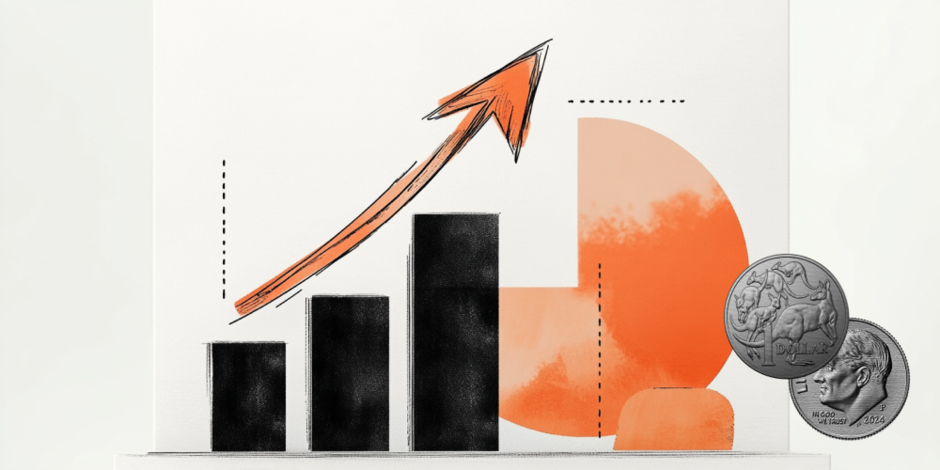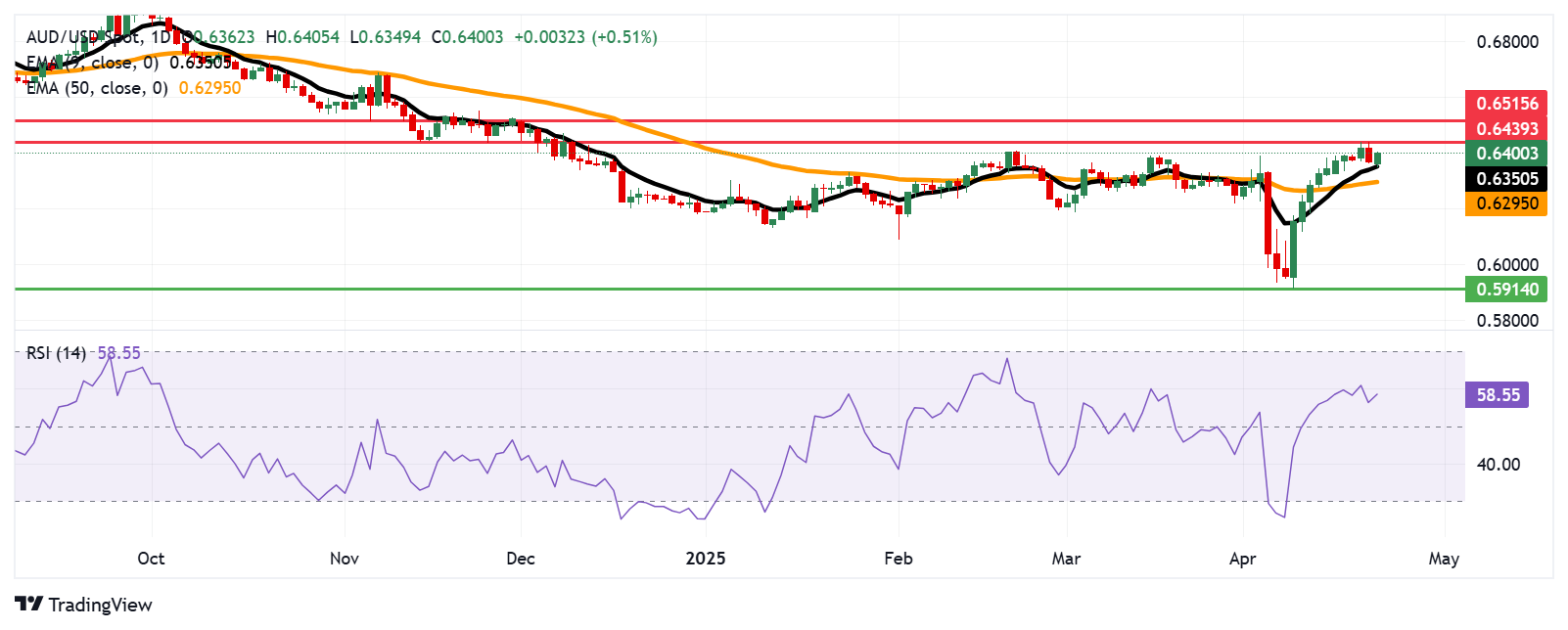Created
: 2025.04.23














![]() 2025.04.23 10:34
2025.04.23 10:34
The Australian Dollar (AUD) recovered some ground on Wednesday, retracing its losses from the previous session. The AUD/USD pair stabilized following the release of preliminary data from Australia's Judo Bank Purchasing Managers Index (PMI), which showed that private sector activity expanded for the seventh consecutive month in April, driven by continued growth in both manufacturing and services output.
The Judo Bank Manufacturing PMI edged down to a two-month low of 51.7 in April, compared to 52.1 in March. While manufacturing output remained in expansion territory, the increase in new orders was modest. Meanwhile, the Services PMI dipped slightly to 51.4 from 51.6 in the previous month, and the Composite PMI also eased to 51.4 from 51.6.
The AUD/USD pair came under pressure as the US Dollar (USD) strengthened, supported by comments from US Treasury Secretary Scott Bessent, who described the ongoing tariff standoff as "unsustainable," suggesting a potential move toward de-escalation. Market sentiment was further boosted by US President Donald Trump, who reassured investors that he has no intention of removing Federal Reserve (Fed) Chair Jerome Powell, helping ease concerns about central bank independence and policy direction.
The AUD/USD pair is hovering near 0.6390 on Wednesday, with daily chart technicals signaling a bullish bias. The pair remains above the nine-day Exponential Moving Average (EMA), while the 14-day Relative Strength Index (RSI) holds firm above the 50 mark--both indicators pointing to continued upward momentum.
On the upside, immediate resistance lies at the recent four-month high of 0.6439, reached on April 22. A clear break above this level could open the door for a rally toward the five-month high of 0.6515.
To the downside, initial support is seen at the nine-day EMA near 0.6350, followed by stronger support around the 50-day EMA at 0.6295. A sustained move below these levels could invalidate the current bullish outlook and expose the pair to deeper losses, potentially targeting the March 2020 low near 0.5914.

The table below shows the percentage change of Australian Dollar (AUD) against listed major currencies today. Australian Dollar was the strongest against the Swiss Franc.
| USD | EUR | GBP | JPY | CAD | AUD | NZD | CHF | |
|---|---|---|---|---|---|---|---|---|
| USD | 0.24% | 0.19% | 0.36% | 0.11% | -0.57% | -0.26% | 0.45% | |
| EUR | -0.24% | -0.07% | 0.10% | -0.14% | -0.78% | -0.51% | 0.21% | |
| GBP | -0.19% | 0.07% | 0.17% | -0.08% | -0.70% | -0.45% | 0.29% | |
| JPY | -0.36% | -0.10% | -0.17% | -0.26% | -0.83% | -0.65% | 0.12% | |
| CAD | -0.11% | 0.14% | 0.08% | 0.26% | -0.57% | -0.35% | 0.37% | |
| AUD | 0.57% | 0.78% | 0.70% | 0.83% | 0.57% | 0.27% | 1.02% | |
| NZD | 0.26% | 0.51% | 0.45% | 0.65% | 0.35% | -0.27% | 0.74% | |
| CHF | -0.45% | -0.21% | -0.29% | -0.12% | -0.37% | -1.02% | -0.74% |
The heat map shows percentage changes of major currencies against each other. The base currency is picked from the left column, while the quote currency is picked from the top row. For example, if you pick the Australian Dollar from the left column and move along the horizontal line to the US Dollar, the percentage change displayed in the box will represent AUD (base)/USD (quote).
The Manufacturing Purchasing Managers Index (PMI), released on a monthly basis by Judo Bank and S&P Global, is a leading indicator gauging business activity in Australia's manufacturing sector. The data is derived from surveys of senior executives at private-sector companies. Survey responses reflect the change, if any, in the current month compared to the previous month and can anticipate changing trends in official data series such as Gross Domestic Product (GDP), industrial production, employment and inflation. The index varies between 0 and 100, with levels of 50.0 signaling no change over the previous month. A reading above 50 indicates that the manufacturing economy is generally expanding, a bullish sign for the Australian Dollar (AUD). Meanwhile, a reading below 50 signals that activity among goods producers is generally declining, which is seen as bearish for AUD.
Read more.Last release: Tue Apr 22, 2025 23:00 (Prel)
Frequency: Monthly
Actual: 51.7
Consensus: -
Previous: 52.1
Source: S&P Global
![]()
Created
: 2025.04.23
![]()
Last updated
: 2025.04.23

FXStreet is a forex information website, delivering market analysis and news articles 24/7.
It features a number of articles contributed by well-known analysts, in addition to the ones by its editorial team.
Founded in 2000 by Francesc Riverola, a Spanish economist, it has grown to become a world-renowned information website.
We hope you find this article useful. Any comments or suggestions will be greatly appreciated.
We are also looking for writers with extensive experience in forex and crypto to join us.
please contact us at [email protected].
Disclaimer:
All information and content provided on this website is provided for informational purposes only and is not intended to solicit any investment. Although all efforts are made in order to ensure that the information is correct, no guarantee is provided for the accuracy of any content on this website. Any decision made shall be the responsibility of the investor and Myforex does not take any responsibility whatsoever regarding the use of any information provided herein.
The content provided on this website belongs to Myforex and, where stated, the relevant licensors. All rights are reserved by Myforex and the relevant licensors, and no content of this website, whether in full or in part, shall be copied or displayed elsewhere without the explicit written permission of the relevant copyright holder. If you wish to use any part of the content provided on this website, please ensure that you contact Myforex.
Myforex uses cookies to improve the convenience and functionality of this website. This website may include cookies not only by us but also by third parties (advertisers, log analysts, etc.) for the purpose of tracking the activities of users. Cookie policy